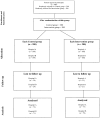Impact of Pharmacist Educational Intervention on Costs of Medication with Improved Clinical Outcomes for Diabetic Patients in Various Tertiary Care Hospitals in Malaysia: A Randomized Controlled Trial
- PMID: 40281848
- PMCID: PMC12027136
- DOI: 10.3390/healthcare13080901
Impact of Pharmacist Educational Intervention on Costs of Medication with Improved Clinical Outcomes for Diabetic Patients in Various Tertiary Care Hospitals in Malaysia: A Randomized Controlled Trial
Abstract
Background and objective: A lifestyle-associated disease, diabetes mellitus, mandates compliance with established policies by physicians and patients to achieve optimal glycemic control. Collaborative care from health care providers and patients is essential for effective management, which slows disease progression, improves quality of life, and reduces medication costs. This study assessed the effectiveness of pharmacist-led educational initiatives provided to patients on clinical outcomes and direct treatment costs for those with diabetes in two public hospitals in Malaysia.
Methods: Four hundred type 2 diabetes patients included in this study were randomly allocated to two corresponding groups. The control group, consisting of 200 patients (100 from each hospital), received standard treatment using the Malaysian Clinical Practice Guideline 2015, while the intervention group, also comprising 200 patients (100 from each hospital), received pharmacist-led care through Diabetic Medication Therapy Adherence Clinics (DMTACs), including pharmacist-provided education, alongside conventional treatment. The patients were equally selected from both hospitals based on the sample size calculation. The pharmacists provided educational interventions emphasizing dietary adjustments, lifestyle modifications, the significance of physical activity, and appropriate medication storage. Among these, 143 control patients and 156 intervention patients completed this one-year study, which comprised an initial and two follow-up visits. Clinical outcomes and treatment expenses were evaluated, and a data analysis was performed utilizing version 24 SPSS. Descriptive statistics were presented as the mean ± standard deviation, including normality assessed using the skewness, kurtosis, and Kolmogorov-Smirnov test. Independent t-tests were applied for hypothesis testing when the data showed normal distribution. Paired t-tests were used for cost assessments.
Results: After the research, the group receiving intervention had a much higher decrease in HbA1c levels relative to the control group (3.59% versus 2.17%; p < 0.001). The intervention group had considerable decreases in systolic blood pressure (9.29 mmHg) and similarly in diastolic blood pressure (7.58 mmHg; with p < 0.005). Additionally, the levels of cholesterol in the intervention group improved significantly (0.13 mmol/L; p < 0.001). Moreover, treatment expenses for the pharmacist-led intervention group showed a substantial reduction (p < 0.001). By the second follow-up, the additional cost per patient since baseline was MYR 236.07 (Malaysian Ringgit), approximately 53.45 USD, in the control group, compared to only MYR 47.33 per patient, approximately 10.72 USD, in the intervention group with pharmacist involvement. Only medication costs were considered, and all unnecessary medications were discontinued as patient clinical outcomes improved sufficiently with pharmacist intervention, allowing for management through lifestyle changes alone. Counseling costs were not included since the pharmacists providing education were already employed in these hospitals, and no additional pharmacists were appointed for this purpose.
Conclusion: Pharmacist-led interventions led to a significant improvement in HbA1c levels. While medication expenses increased in both groups from the initial follow-up, the control group exhibited a significantly greater increase in costs and HbA1c levels than the intervention group.
Keywords: cost of medication; diabetes mellitus; glycated hemoglobin (HbA1c); lifestyle modification; pharmacist-led educational intervention.
Conflict of interest statement
The authors declare no conflicts of interest.
References
-
- American Pharmacists Association Pharmacists’ Impact on Patient Safety. 2016. [(accessed on 25 March 2025)]. Available online: https://www.pharmacist.com/Portals/0/PDFS/Practice/PharmacistsImpactonPa....
Grants and funding
LinkOut - more resources
Full Text Sources


